Ireland Driving Test 12
This is a timed quiz. You will be given 60 seconds per question. Are you ready?
The driver is approaching traffic lights that they know have been green for some time. What should the driver do?
Explantion: You should always read the road ahead and be prepared to react to changing traffic situations. Where traffic lights have been green for some time, you should be prepared to stop, as the lights are probably about to change to amber.
What must a driver be prepared for in this situation?
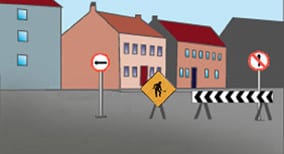
Explantion: When you are approaching road works, you should be prepared to divert around or through them and drive at a slower speed. At road works, the road surface may be uneven or dirty.
The bus ahead is moving away from a bus stop. What should a driver do?
Explantion: A driver should allow signalling buses back into the stream of traffic when they are moving out from a stop. Be careful of pedestrians getting on and off buses, particularly of children near schools.
When preparing to stop, a driver notices the vehicle behind is towing a trailer. What should the driver do?
Explantion: When you are slowing or stopping, you should be mindful of the type of vehicle that is following you. For example, if the vehicle following you is a large vehicle or one towing a trailer, you should think of indicating a little earlier than normal to allow the following vehicle enough time to react safely.
What should a driver who wants to turn right do in this situation?
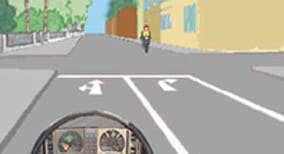
Explantion: As you approach a junction where you want to turn right, you should read the road ahead and take up the correct position for turning in good time.
What should a driver be aware of in this situation?
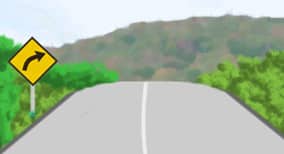
Explantion: You should always read the road ahead and be prepared to react to changing traffic situations - in this case paying attention to the warning sign clearly indicating a right-hand bend ahead.
What should the driver do if there are cattle on the road ahead?
Explantion: You should always read the road ahead and be prepared to react to changing traffic situations. If you meet horses or other animals on the road, you should slow down and be prepared to stop. Don't use the horn or do anything that might frighten the animals. You must stop if directed to do so by the person in charge of animals.
What should a driver do if they see horse riders on the road ahead?
Explantion: You should always read the road ahead and be prepared to react to changing traffic situations. If you meet horses or other animals on the road, you should slow down and be prepared to stop. Don't use the horn or do anything that might frighten the animals. You must stop if directed to do so by the person in charge of animals.
What should the driver do when approaching a humpbacked hill?
Explantion: As you approach a humpbacked bridge or hill, you should be aware that there might be hidden dangers ahead-for example, overtaking traffic coming towards you. You should always read the road ahead and be prepared to react to changing traffic situations such as this.
What should a driver do on a narrow road when another vehicle is coming in the opposite direction?
Explantion: You should always be prepared to react to hazards ahead.When you meet a vehicle coming against you on a narrow road,you should show consideration and slow down to an appropriate speed so that the two vehicles can pass each other safely.
Which vehicle is in the correct position to make a right turn from the major road into the minor road?
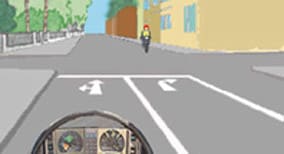
Explantion: The correct position from which to turn right from a major road to a minor road is just left of centre. You should take up the correct position in good time and avoid cutting the corner or 'swan necking' - that is going beyond the turning point as car 2 is in the picture.
What should a driver do if they see a red warning triangle on the road?
Explantion: Warning triangles are used to alert approaching traffic that there is a vehicle breakdown or collision ahead. When you come across a warning triangle, you should slow down and prepare to stop if necessary. Do not allow yourself to be distracted by the incident.
Which vehicle is in the correct position to make a right turn from a minor road onto a major road?
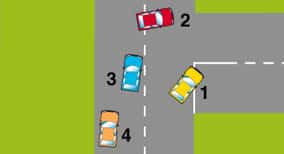
Explantion: The correct position from which to turn right from a minor road to a major road is just left of centre of the road. You should take up the correct position in good time and complete the turn by entering the left-hand side of the major road.
There are pedestrians on the footpath ahead and there are pools of water on the road. What should a driver do?
Explantion: During wet conditions, you should be aware that surface water can affect the stability of your vehicle. This is particularly so where the water lies in pools. As you drive through surface water, you should show consideration to pedestrians and cyclists and try not to splash them as you pass.
What do flashing amber beacons on an oncoming vehicle alert a driver to?
Explantion: Flashing amber beacons are used by recovery vehicles and vehicles carrying abnormal loads.You should be aware that these vehicles may need extra room and could conceal following traffic.When you come across such vehicles, slow down and be prepared to stop if necessary.
What should drivers be aware of if they meet horses with riders on the road?
Explantion: You must know your responsibilities towards animal traffic on the road. Horses are easily startled and any sudden activity or noises could cause the to bolt.
What should a driver do when approaching a junction normally controlled by traffic lights and the traffic lights are not lighting?
Explantion: You should always read the road ahead and be prepared to react to changing traffic situations. If the traffic lights are not working, you should approach the junction with extra care, and you should proceed only if it is safe to do so.
What should a driver do if they meet a vehicle with flashing amber beacons?
Explantion: Flashing amber beacons are used by recovery vehicles and vehicles carrying abnormal loads.You should be aware that these vehicles may need extra room and could conceal following traffic.When you come across such vehicles, slow down and be prepared to stop if necessary.
What should a driver do if there is a large oil spill on the road?
Explantion: Where oil is spilt on the road, your tyres will have reduced grip, and you might be at risk if you break sharply. If you do come across oil in the road, brake gently and switch on your hazard warning lights for a short period to alert other traffic to the hazard.
What should a driver be aware of before crossing railway or tram lines?
Explantion: You should be aware of the impact of changes in the roads surface. For example, at railway and tram crossings the uneven surface or oil deposits could reduce the grip of your tyres. Slow down as you approach railway or tram crossings and increase your distance from the vehicle in front.
What should the driver be aware of when crossing road markings such as lines and directional arrows?
Explantion: You should be aware of the impact of changes in the roads surface. For example, road markings and directional arrows can become slippery when wet. Where possible, avoid driving on road markings, and be aware of the increased risk of skidding.
What should a driver do in this situation?
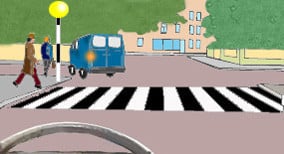
Explantion: When approaching a zebra crossing, you must yield to pedestrians already on or about to cross the road.
What should the driver do when there is a sharp dip in the road ahead?
Explantion: As you approach a sharp dip in the road, you should be aware that there might be hidden dangers ahead. For example, there might be pedestrians, cyclists or other approaching traffic, or the road could be flooded in the clip. You should always read the road ahead and be prepared to react to changing traffic situations - you might need to reduce your speed and drive with extra care.
What should a driver be prepared for in this situation?
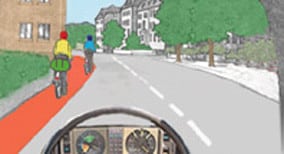
Explantion: When approaching cyclists to overtake them, you should be aware that they might change direction or stop.